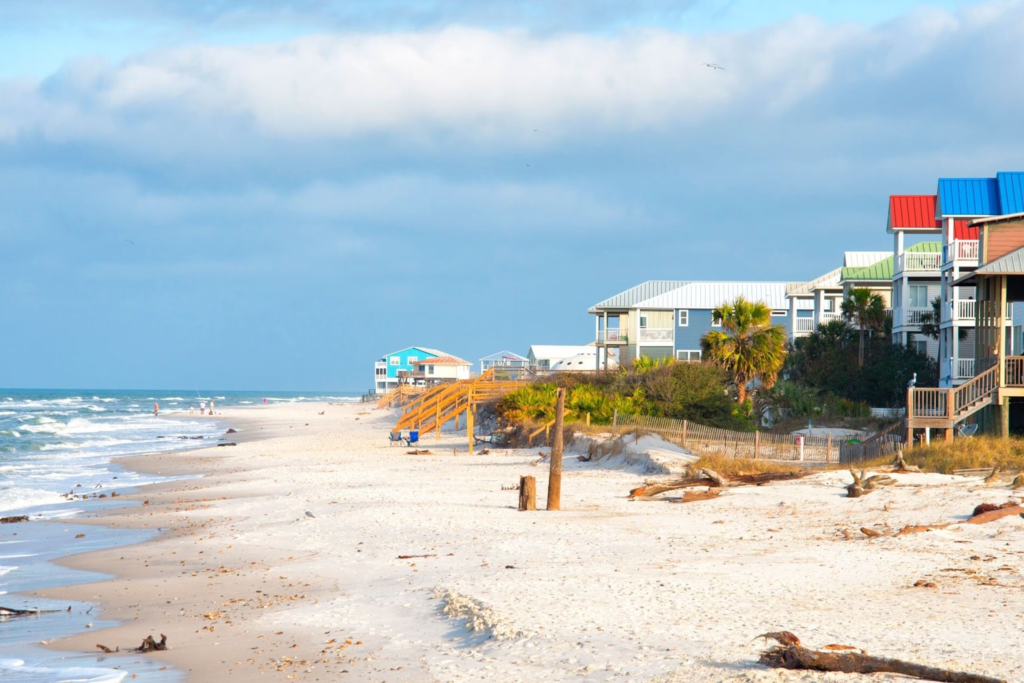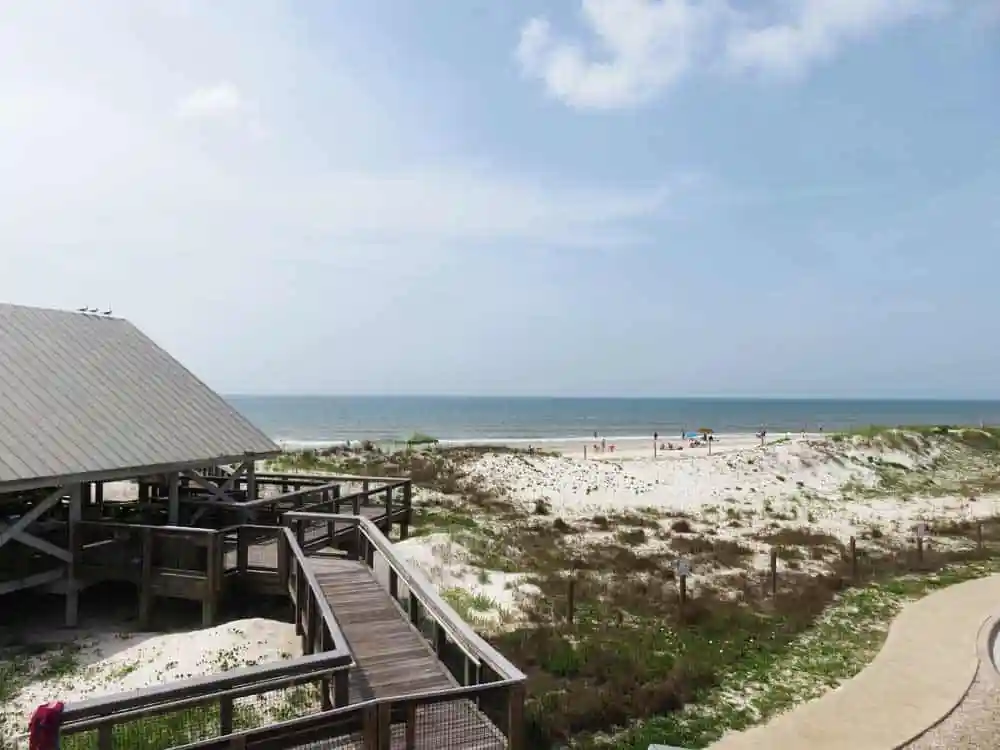Key Takeaways:
- Apalachicola is located on Florida’s Panhandle and has access to several stunning beaches.
- The main beaches near Apalachicola are St. George Island and Cape San Blas which boast miles of pristine white sand.
- St. George Island has a popular public beach with amenities like bathrooms, picnic areas, and a playground.
- Cape San Blas offers over 17 miles of peaceful, uncrowded beaches perfect for relaxation.
- The Apalachicola Bay region also has protected coves, marshes, and shallow bays ideal for nature activities.

Introduction?
With its access to the Gulf of Mexico, quaint seaside character, and renown for oysters, Apalachicola is a beloved getaway destination in Florida’s Panhandle region. But does this historic town actually have a beach of its own? While Apalachicola itself does not contain any beaches within its city limits, visitors will be delighted to discover there are plenty of spectacular sandy stretches just a short drive away.
This article will provide a comprehensive guide to the nearest and best beaches accessible from Apalachicola. We’ll evaluate the different options based on size, amenities, crowds, recreational activities and overall atmosphere. You’ll learn everything you need to select the right beach retreat to complement your Apalachicola vacation. From the expansive St. George Island to the peaceful solitude of Cape San Blas, there are diverse beach experiences to discover.
With miles of sparkling white sand, gentle surf, opportunities for swimming, shelling or simply relaxing oceanside, the stunning beaches around Apalachicola offer the perfect complement to the town’s charms. Spend a day lounging on the beach before returning to enjoy fresh caught seafood from the bay. By providing the ideal tranquil beach getaway without the overwhelming crowds of more touristy beach destinations, the Apalachicola region truly provides the best of both worlds for travelers.
What Public Beaches Are Near Apalachicola?
The two most popular public beaches near Apalachicola are St. George Island State Park and Cape San Blas. Both offer extensive stretches of pristine white sand along the Gulf of Mexico, about a 30-45 minute drive from Apalachicola. The long undeveloped shorelines and tranquil atmospheres distinguish these beaches from the busier scenes found in Destin or Panama City. Let’s explore the highlights of each to help you select the right beach for the experience you desire.

What Does St. George Island Offer?
Located just off Apalachicola Bay, St. George Island State Park offers 9 miles of secluded beach adored for its sparkling white sands and untamed wilderness. According to a visitor survey conducted by the University of Florida, over 90% of visitors rated the beach as excellent.
The park features:
- A public beach area with restroom facilities, covered pavilions and picnic areas.
- A playground and ball court for family recreation.
- Nature trails for birding, hiking and biking.
- Opportunities for swimming, shelling, fishing and kayaking.
- Campsites and cabins available for overnight stays.
With gentle surf that creates shallow onshore troughs, St. George Island offers excellent swimming and shelling opportunities. The park’s location on the island’s east end shelters it from strong currents. As a result, the water warms earlier in the spring than other Gulf beaches.
The public beach area does get busy in peak seasons, but the park’s size allows for pockets of seclusion. Early risers can stake out a perfect spot and spend the day enjoying the soft white sand and tranquil views.
According to a biological survey, St. George Island State Park protects one of the most diverse natural areas along Florida’s Gulf Coast, making it great for nature lovers.
What Are the Highlights of Cape San Blas?
Extending southeast from Port St. Joe, Cape San Blas features over 17 miles of pristine sugar-white beaches with hardly any development. The spacious, slow-sloping beaches offer unparalleled opportunities for relaxation and solitude. Cape San Blas caters more to beachcombers, swimmers, surf fishers, kayakers and nature lovers than rowdy spring break crowds.
Highlights include:
- Miles of peaceful shoreline with hardly a soul in sight.
- Crystalline water with a slow offshore slope perfect for swimming.
- Excellent year-round shelling with an abundance of whole shells.
- Salter Path, a picturesque 2-mile bike/hike trail running along the cape.
- Protected coves in St. Joseph Bay perfect for kayaking.
- Opportunities for surf fishing with easy access to Gulf fishing piers.
Whether you seek to experience the marvelous sunrises, photograph the striking sunsets, or simply need a restorative retreat, Cape San Blas offers the quintessential pristine beach experience. The relaxing pace, untouched vistas and wealth of nature perfectly balance the charms of historic Apalachicola.
How Does the Apalachicola National Estuarine Research Reserve Offer Access to Nature?

In addition to its spectacular beaches, the Apalachicola region also provides opportunities for nature lovers to explore protected marshes, shallow bays and coastal habitats.
The Apalachicola National Estuarine Research Reserve spans over 246,000 acres, safeguarding one of the most biologically diverse estuaries in the nation. Popular activities include:
- Kayaking through the shallow bays and intricate creeks of the St. Vincent Sound.
- Hiking on 6 different trails through distinct habitats including pine flatwoods, coastal marshland and Apalachicola River floodplain.
- Spotting over 200 bird species including bald eagles, osprey, herons and plovers.
- Fishing in Apalachicola Bay, named Florida’s “most productive bay.”
- Volunteering for conservation programs like debris cleanup events or bird surveys.
According to researchers with the FSU Coastal and Marine Lab, the Apalachicola Reserve contains over 784 species of plants and animals, providing an abundance of wildlife viewing opportunities.
Overnight camping is available on several small, peaceful primitive islands only accessible by boat. This offers a one-of-a-kind opportunity to experience the rhythms of this coastal wilderness region up close.
Frequently Asked Questions:
How far are the beaches from downtown Apalachicola?
The drive from downtown Apalachicola to St. George Island is approximately 30 minutes covering 24 miles. Cape San Blas is about 50 minutes away or 43 miles by car. The short drive makes it easy to enjoy both the charms of historic Apalachicola and the expansive beaches of the barrier islands.
Where can you find beach amenities like restrooms and showers?
St. George Island State Park has covered picnic shelters, restroom facilities and outdoor showers conveniently located near the public beach access area. Cape San Blas does not offer amenities, so be sure to come prepared when visiting.
Are there boardwalk access points or wheelchair accessible routes to the beach?
Yes, the main public beach area at St. George Island State Park offers boardwalk access over the dunes with wheelchair accessible ramps leading right out onto the beach. At Cape San Blas, sturdy wooden walkovers help traverse the dune system to reach the shoreline.
Are dogs allowed? What about other pets?
Dogs are welcome in St. George Island State Park but must be leashed at all times. They are allowed on the beach near the public access point. No other pets are allowed. At Cape San Blas, dogs are also permitted as long as they are leashed. Owners should follow proper pet etiquette and clean up after their dogs.
Can you camp right on the beach?
Overnight camping is available at St. George Island State Park with sites set on both the bay and gulf sides. Reservations often fill up months in advance. Backcountry camping on Cape San Blas is not permitted. The St. Joseph Peninsula State Park located on the bayside of Cape San Blas offers campsites, but they are not directly on the beach.
Are there lifeguards on duty?
No, neither St. George Island nor Cape San Blas have lifeguards monitoring the beaches. Use caution, pay attention to posted warnings, and supervise children closely when swimming. Avoid swimming alone.
What are the best beach areas for finding shells?
The entire shoreline of Cape San Blas is renowned as one of the best shelling beaches in the country due to its shallow slope, diverse habitats and currents that deposit shells. The best time is during winter or after storms when waves uncover buried treasures. St. George Island is also excellent for shell hunting, especially along the east end. Scour the wrack line for sharks teeth, coquinas, whelks, olives, scallops and more!
In summary, though Apalachicola itself doesn’t contain any beaches within the city, visitors have easy access to some of the Panhandle’s most scenic and unspoiled beaches. The long stretches of powdery white sand at St. George Island State Park and Cape San Blas offer the perfect peaceful beach retreat to pair with Apalachicola’s captivating coastal charms
- How Many Wards are in New Orleans? An In-Depth Look at the Crescent City’s Distinct Neighborhoods
- Where Are the Bald Eagles at Conowingo Dam?
- Can You Drink in Dubai?
- Why Was the Caravel Ship so Important?
- How Long Is the Flight From Detroit to Punta Cana?
- Can You Rent Umbrellas at Lewes Beach?
- How Does Capital One Venture One Miles Work?
- How Does Capital One Venture One Miles Work?
- Is Colwyn Bay Rough? Examining the Reputation and Reality
- Is Elmont NY on Long Island?
- Why Is Your Blendjet Blinking Red?
- What Is Mucoid Degeneration of Acl?
- How to Start Your Own Tequila Brand?
- Will the UK Build a Third Aircraft Carrier?
- how fast does a pickleball travel?
- Is There Room for Negotiation?
- Do Yeasts Have Plasmids?
- How to Spell Katie? Resolving the Various Ways to Spell This Popular Name
- Does Tween 20 Lyse Cells?
- Why Should an Advertiser Consider Using Responsive Display Ads?
- How to Clean a Meth Pipe?
- Does Raiders Stadium Have Grass? An In-Depth Look at the Playing Surface